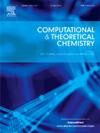Investigating the poisoning mechanism induced by K and SO2 coexistence in the NH3-SCR of NOx over CrMn1.5O4 catalysts
IF 3
3区 化学
Q3 CHEMISTRY, PHYSICAL
引用次数: 0
Abstract
The manganese-based spinel-type catalyst (CrMn1.5O4) shows excellent low-temperature activity for selective catalytic reduction (NH3-SCR) but is hindered by alkali metals (notably potassium) and SO2 in flue gas. This study uses density functional theory (DFT) and experiments to investigate K and SO2 poisoning mechanisms. K adsorption decreases NH3 adsorption energy and increases the NH3 dehydrogenation energy barrier. SO2 occupies multiple Lewis acid sites, reducing NO adsorption energy. Interestingly, co-poisoning with SO2 and K enhances denitrification performance compared to K alone. SO2 interacts with K, inhibiting electron transfer, reducing the reaction energy barrier for NH3 dehydrogenation, and mitigating K poisoning. Thus, the detoxification effect between SO2 and K in the actual reaction atmosphere mitigates the toxicity of alkali metals to the catalyst. This finding provides valuable guidance for designing manganese-based spinel-type catalysts with high resistance to toxicity.

在CrMn1.5O4催化剂上研究K和SO2共存对NOx NH3-SCR的中毒机理
锰基尖晶石型催化剂(CrMn1.5O4)表现出优异的低温选择性催化还原(NH3-SCR)活性,但受到烟道气中碱金属(特别是钾)和SO2的阻碍。本研究利用密度泛函理论(DFT)和实验研究了K和SO2中毒机制。K吸附降低了NH3的吸附能,增加了NH3脱氢能垒。SO2占据多个路易斯酸位点,降低NO的吸附能。有趣的是,与单独K相比,SO2和K共同中毒可以提高反硝化性能。SO2与K相互作用,抑制电子转移,降低NH3脱氢反应能垒,减轻K中毒。因此,实际反应气氛中SO2和K之间的解毒作用减轻了碱金属对催化剂的毒性。这一发现为设计高抗毒性的锰基尖晶石型催化剂提供了有价值的指导。
本文章由计算机程序翻译,如有差异,请以英文原文为准。
求助全文
约1分钟内获得全文
求助全文
来源期刊

Computational and Theoretical Chemistry
CHEMISTRY, PHYSICAL-
CiteScore
4.20
自引率
10.70%
发文量
331
审稿时长
31 days
期刊介绍:
Computational and Theoretical Chemistry publishes high quality, original reports of significance in computational and theoretical chemistry including those that deal with problems of structure, properties, energetics, weak interactions, reaction mechanisms, catalysis, and reaction rates involving atoms, molecules, clusters, surfaces, and bulk matter.
 求助内容:
求助内容: 应助结果提醒方式:
应助结果提醒方式:


